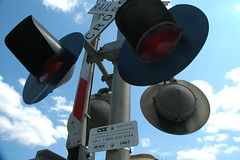 Some SMART opponents have been arguing that the SMART train will cause massive traffic congestion along its route whenever it closes the crossing gates.
Some SMART opponents have been arguing that the SMART train will cause massive traffic congestion along its route whenever it closes the crossing gates.
The idea is that SMART will run most often at rush hour, when our roads are busiest, and that it would cross over some fairly busy roads at grade. The crossing gates would close for a time, backups would result, and rush hour would be ruined for everyone. This analysis deserves examination.
Federal guidelines on the subject require crossing arms to close at least 20 seconds before a train passes, and open no more than 12 seconds after the train has passed. Though most crossing arms I've seen open almost immediately after the train has passed, let's say the gate will be closed at least 32 seconds.
If a 170-foot SMART train is moving at 25 miles per hour, or 37 feet per second, it will clear a 35-foot wide intersection in less than 6 seconds. If it's slowing to a stop, such as around Fourth Street in San Rafael, it might travel at about a fifth that speed, and will cross the same intersection in 28 seconds. SMART's design documents say it will run at the same speed as parallel streets, so these are reasonable speeds to assume. Added these times to the minimum closure time and we find a maximum an approximate wait delay of 60 seconds, roughly the same amount of time as a normal traffic light. Thanks to long headways, each grade crossing will have to endure, at most, 60 seconds of delay twice four times per hour.
In the populated areas SMART will cross through, the crossing arms will communicate with with the rest of the traffic light system. That will further minimize the effect of the train's activities on local traffic flow.
It seems, then, that the concern is overheated. While freight trains extending thousands of feet in length would cause major congestion, the relatively short SMART trains will be speedy enough so as not to cause a problem. With intelligent traffic engineering, they won't be any more of a pain than traffic lights are now.
This post has been updated for clarity.